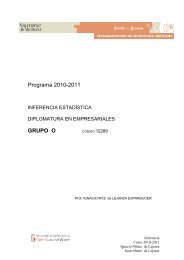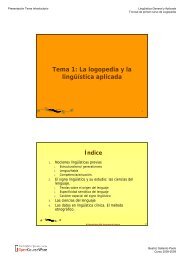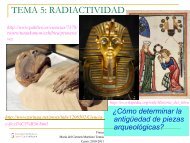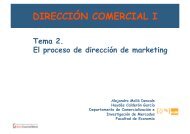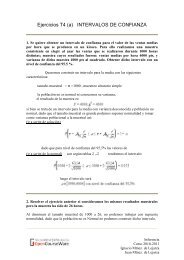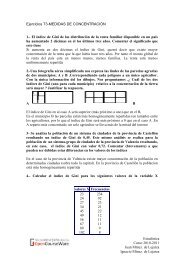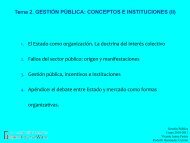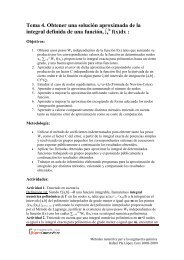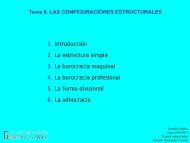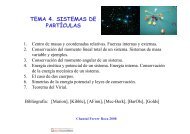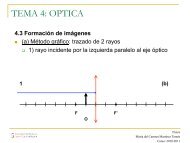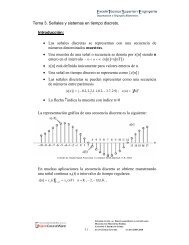Act of utterance and the utterance, act of utterance - OCW de la ...
Act of utterance and the utterance, act of utterance - OCW de la ...
Act of utterance and the utterance, act of utterance - OCW de la ...
- No tags were found...
Create successful ePaper yourself
Turn your PDF publications into a flip-book with our unique Google optimized e-Paper software.
05.02. Enunciative analysis <strong>of</strong> impaired speech samples: speech <strong>act</strong>s - 101to what happens in spontaneous dialogue. Basically, it does not seemfeasible that any listener would really want to interrupt a recor<strong>de</strong>d voice,particu<strong>la</strong>rly if <strong>the</strong> topic was not <strong>of</strong> <strong>the</strong>ir own choosing (Beattie, 1977) 22 .- EMPTY PAUSES AT LEAST TWO SECONDS LONG [PV]; ethnomethodologistsi<strong>de</strong>ntified <strong>the</strong> 1 second pause as <strong>the</strong> st<strong>and</strong>ard length <strong>of</strong> <strong>the</strong> pause within <strong>the</strong>turn 23 . Crockford <strong>and</strong> Lesser proposed including pauses <strong>of</strong> over 2 secondsin editing tasks, <strong>and</strong> this is <strong>the</strong> criterion we have adopted.- DRAFT ACTS [AB]: this inclu<strong>de</strong>s expressions uttered by <strong>the</strong> speaker in <strong>the</strong>irefforts to run through a lexical series in or<strong>de</strong>r to find <strong>the</strong> lexical element<strong>the</strong>y are searching for, toge<strong>the</strong>r with <strong>the</strong> failed attempts to find a particu<strong>la</strong>rword or expression, <strong>the</strong> circumlocutions that reveal lexical access problems,or specific questions on <strong>de</strong>nomination; <strong>the</strong>y are tests, failed attempts,tentative expressions. The example shows intervention 0052, where wec<strong>la</strong>ssify as a "draft <strong>act</strong>" <strong>the</strong> series <strong>of</strong> numbers until <strong>the</strong> target-number isfound.- TAG QUESTIONS [PC]: we inclu<strong>de</strong> <strong>the</strong>se in editing tasks as <strong>the</strong>y are aninstrument used by <strong>the</strong> aphasic speaker to verify <strong>the</strong>ir conversationalpartner's un<strong>de</strong>rst<strong>and</strong>ing, ins<strong>of</strong>ar as <strong>the</strong>y give a possible p<strong>la</strong>ce forinterruption (Transition Relevance P<strong>la</strong>ce, TRP).- This leads to cases <strong>of</strong> motor aphasia in which this type <strong>of</strong> question is overused:¿no?, ¿eh?In non-aphasic conversation, tag questions typically occupy <strong>the</strong> linkingposition in re<strong>la</strong>tion to <strong>la</strong>ter interventions (position 3 in <strong>the</strong> i<strong>de</strong>alintervention structure) 24 ; however, in aphasic conversations <strong>the</strong>seinterrogative <strong>utterance</strong>s are not a real h<strong>and</strong>over <strong>of</strong> <strong>the</strong> conversational turn,on <strong>the</strong> contrary, <strong>the</strong>y are used as a turn-keeping strategy.• NON-VERBAL ACTS: <strong>the</strong> transcription attempts to reflect <strong>the</strong> gestures used by <strong>the</strong>speaker at three basic levels: emblems, illustrators <strong>and</strong> regu<strong>la</strong>tors, adopting <strong>the</strong>basic c<strong>la</strong>ssification <strong>of</strong> non-verbal behaviours put forward by Eckman <strong>and</strong> Friesen 25 .This information is essential in speakers with motor aphasias, as <strong>the</strong> gesture quitefrequently accompanies <strong>and</strong> supports speech, sometimes substituting it completely.We co<strong>de</strong> as [NV] non-verbal speech <strong>act</strong>s consi<strong>de</strong>red pertinent to <strong>the</strong> transcription.incomplete with filled pause (making a total <strong>of</strong> 32 <strong>utterance</strong>s). In <strong>the</strong> second experiment <strong>the</strong>y worked with120 stu<strong>de</strong>nts divi<strong>de</strong>d into four groups. They listened to lists <strong>of</strong> numbers read by a same speaker, thaten<strong>de</strong>d unexpectedly <strong>and</strong> <strong>the</strong>y were asked to say which was <strong>the</strong> <strong>la</strong>st number before <strong>the</strong> speaker announcedthat <strong>the</strong>y had finished. The material consisted in lists <strong>of</strong> r<strong>and</strong>om numbers: five long lists <strong>and</strong> three short.Four different versions were prepared <strong>of</strong> <strong>the</strong> five long lists: in one <strong>the</strong> word "stop" was ad<strong>de</strong>d after <strong>the</strong> <strong>la</strong>stnumber; in ano<strong>the</strong>r two one-<strong>and</strong>-a-half second pauses were inserted; in <strong>the</strong> o<strong>the</strong>r two a filled pause wasad<strong>de</strong>d at <strong>the</strong> beginning <strong>and</strong> at <strong>the</strong> end <strong>of</strong> <strong>the</strong> one-<strong>and</strong>-a-half second pauses.22 Beattie, Ge<strong>of</strong>frey W. (1977): "The dynamics <strong>of</strong> interruption <strong>and</strong> <strong>the</strong> filled pause", British Journal <strong>of</strong> Social<strong>and</strong> Clinical Psychology, 16.23 Jefferson, Gail (1989): “Preliminary Notes on a Possible Metric which Provi<strong>de</strong>s for a St<strong>and</strong>ard MaximumSilence <strong>of</strong> Approximately One Second in Conversation”, in Roger D. <strong>and</strong> Bull P., eds: (1989): Conversation:an interdisciplinary perspective. Clevedon: Multilingual Matters; p. 166-196.Gal<strong>la</strong>rdo Paúls, Beatriz (1993): “La transición entre turnos conversacionales: silencios, interrupciones yso<strong>la</strong>pamientos”, Contextos XI/21-22: 189-220.24 Dubois B, Crouch I. (1975): The question <strong>of</strong> tag questions in women's speech: <strong>the</strong>y don't really use more<strong>of</strong> <strong>the</strong>m, do <strong>the</strong>y? Language in Society 4: 289-294.Davidson, Judy (1984): “Subsequent versions <strong>of</strong> invitations, <strong>of</strong>fers, requests <strong>and</strong> proposals <strong>de</strong>aling withpotential or <strong>act</strong>ual rejection”, en Atkinson J.M. <strong>and</strong> Heritage J., eds. Structures <strong>of</strong> Social <strong>Act</strong>ion, Cambridge:University Press. p. 102-128.25 Eckman P, Friesen W. V. (1969): The repertoire <strong>of</strong> nonverbal behaviour: categories, origins, usage <strong>and</strong>codings. Semiotica 6: 238-252.Linguistic Analysis <strong>of</strong> Speech Language Disor<strong>de</strong>rsBeatriz Gal<strong>la</strong>rdo Paúls. Course 2008-2009.



